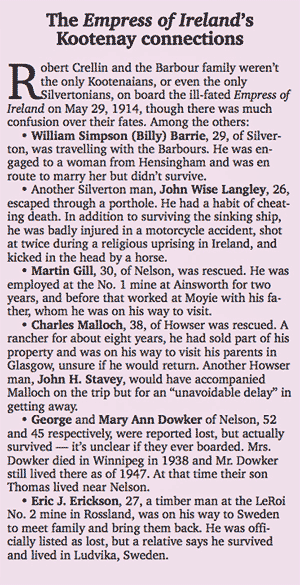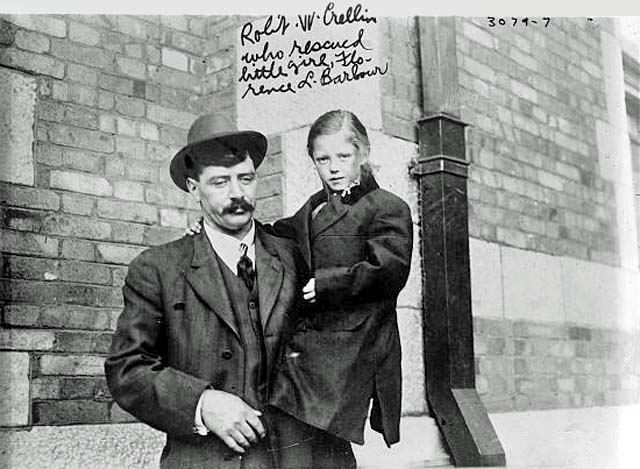|
Robert Crellin of Silverton, British Columbia, with Florence Barbour, whom he rescued from the sinking of the Empress of
Ireland on the St. Lawrence River on 29 May 1914 - Date/Photographer unknown - Bain News Service Library of Congress.
29 May 2014

1914 Silverton Shipwreck Survivors Surface
Silverton British Columbia - Eight-year-old Florence Barbour clung ferociously to Robert Crellin's neck as they fought to stay afloat
in the St. Lawrence River.
Minutes earlier they had been passengers aboard the Empress of Ireland, which collided in the night with the SS Storstad.
Crellin, 35, helped Florence, her mother Sabena, and younger sister Evelyn climb from their second-class cabins to the deck.
As the ship sank beneath them, Crellin put Florence on his back and entered the bone-chilling water.
By one account, he swam for over an hour.
"I finally came across an upturned lifeboat from our steamer and managed to put Florence on it and then straddled it myself," Crellin
recalled.
"Another man climbed aboard and soon we drifted to a collapsible boat, which three of us managed to open and climb into. I dragged two women aboard, and
with a man, saved some men."
In all, he helped rescue more than 20 people.
The tall, rugged man and the golden-haired little girl, both from Silverton, were among the lucky survivors of Canada's deadliest maritime
disaster.
God be Willing We Will Save Everyone
Florence's family was already dealing with tragedy when the ship sank.
Her father, Tom Barbour, was teaming a load of ore down from the Silverton mines in May 1913 when a slide startled his horses, who threw him from his
wagon.
He died in hospital after nine agonizing days, age 38.
"I will never forget my mother's grief and our sad little hearts," Florence wrote many years later.
Tom and Sabena were both from Cumberland in the north of England.
They came to Canada around 1900, where Tom worked in the Slocan silver mines.
Florence Lorraine was born in the now-ghost town of Three Forks in 1904, 1905, or 1906 (sources differ), and the family later moved to the Van Roi mine near
Silverton, where Evelyn Beatrice was born in 1910.
They enjoyed a brief but bucolic childhood.
After Thomas' death, the bereaved family was comforted by frequent visits from Florence's godfather, Robert William Crellin, whom she called Uncle Bob, and
William Simpson (Billy) Barrie.
Both were Cumberland miners who emigrated to B.C. about the same time as the Barbours.
Florence recalled dancing as Bob played the concertina for them.
A year after her husband's death, Sabena booked passage to visit the old country with her daughters.
Bob and Billy joined them, although they tried unsuccessfully to convince Sabena to delay her departure by a few weeks.
Florence's maternal grandmother sent brown velvet dresses for the girls to wear on their trip, but they were too big, so Sabena promised to hem them on the
way.
Florence, who was attending school in Silverton, tearfully left her friends behind, "but as we intended to come back I consoled myself. It would not be
long until I saw them all again."
On 28 May 1914, the party of five boarded the Canadian Pacific ocean liner Empress of Ireland at Quebec City as it set sail for Liverpool.
Just before 2 a.m. the next day, in heavy fog, the Storstad, a Norwegian collier, crashed into the Empress, gashing a hole in its starboard side.
It began to take on water and list badly.
Florence, who shared a cabin with her sister, remembered being awakened by an "awful bump" and being thrown about.
She heard screams in the dark and then her uncle Bob grabbed her.
"Don't be frightened dear, I've got you," he said.
"God be willing, darling, we will save everyone."
Crellin was in his bare feet as he carried her up the slanted corridor, slipping on its highly polished floor.
She was shocked to hear him exclaim "Oh my god!", a phrase never before uttered when she was in earshot.
When they reached the deck, Sabena was holding Evelyn.
"Then as the ship listed we climbed over the rail and walked cautiously down the ship's side to the water's edge, trying to avoid falling into the
portholes," Crellin said.
"Just as we reached the water's edge the ship gave a terrible tremor. We knew it was all over. I saw Mrs. Barbour and her child tottering toward the water
and reaching out their hands to me. I tried to get them, but I couldn't reach them."
In contrast to the Titanic's slow death, the Empress sank in 15 minutes.
Florence said that as Bob tried to hand Sabena a life preserver, someone snatched it away.
Florence's mother screamed her daughter's name, "but we never saw her again... I remember clinging to Uncle Bob and knew I would be safe as long as he had
a hold of me. Thank God Uncle Bob was a big strong man."
Indeed, it was her great fortune that he was a strong swimmer, many people couldn't swim at all.
The whole time, she held on like a barnacle and never cried.
("I felt somehow that I had not let him down by disgracing myself and crying," she wrote.)
"The child was pluckier than a stout man," Crellin told reporters.
"She never even whimpered, and complaint was out of the question. Time and time again I feared Florence would lose her hold, and I would speak to her when
my mouth and eyes were clear. Each time her little hands would clutch me tighter, until it seemed she'd stop my breath, but I welcomed the hold because it
showed she had the pluck and courage needed. You should have seen how the girls and women in Rimouski hugged her when we got ashore."
According to the Daily Telegraph, when Florence arrived later at the Chateau Frontenac in Quebec, still clutching Crellin, she "asked persistently for her
mother. She was a general favourite at the Chateau, and many women went away with tears in their eyes after talking with her."
Crellin's own eyes grew moist recalling how in the space of a year the little girl had lost her whole family.
"Poor child! She's alone in the world, but Florence will never need a friend or home while I have breath in my body."
A newspaper report suggested Sabena's body was recovered and sent back to New Denver, but there's no record of the burial.
(Florence believed her mother was interred in Quebec.)
Neither Billy Barrie nor Evelyn was ever found.
A commission of inquiry blamed the Storstad and its chief officer for wrongly changing course during the fog, but others fingered the Empress captain, who was
on his maiden voyage as its master.
Of 1,477 people on board, 1,012 died.
Of 138 children, Florence was one of a handful to survive, and became a media darling.
Adoption Offers
The Bain News Service captured photos of Florence hanging on to Bob Crellin after their rescue, which appeared in newspapers across North America (although not
in the Nelson Daily News, which wasn't yet printing wire photos).
One survives in the Library of Congress, showing Crellin in the vest and trousers he swam in.
(He was astonished to discover his watch still in his pocket.)
Yet their story isn't known at all today in Silverton, perhaps partly due to newspaper dispatches and a book by Logan Marshall that erroneously said Crellin
was from "Silverstone."
The Daily Telegraph added to the confusion by wrongly stating that Crellin was from Toronto, Florence was from Cumberland, and her father had been killed in
London, Ontario.
The Canadian Pacific Railway was inundated with letters and telegrams "from every part of the United States and Canada" offering to adopt
Florence.
According to the New York Times, "The story of the rescue of this child, has evidently touched many hearts, and scores are desirous of giving her a
home."
Many assumed Crellin, whom news reports described as a "wealthy farmer," would become her guardian, but it wasn't to be, despite the fact he was
Florence's godparent, and wanted to take care of her, and she wanted to stay with him.
Both sets of grandparents claimed custody and eventually her father's side won.
She was sent to England to be raised.
In 1930, Florence married Leonard Harker of Whitehaven.
She managed a friend's sweet shop and lived a meagre existence until her husband was hired at the Sellafield atomic energy plant that was the town's major
industry.
Bob Crellin also continued on to England following the Empress disaster.
When the First World War broke out soon after, he immediately joined an imperial unit, and spent a few years as a prisoner of war in Germany.
In 1916, he married Margaret May Ellison in Whitehaven and was presumably reunited with Florence.
He and his bride returned to New Denver after the war.
"No one will ever know how much I wanted to go back with him, to where I had so many happy memories," Florence said.
Crellin died in Trail in 1944 at 64 and was buried in New Denver.
He was survived by his wife and three children, Ellison, David, and Hilda.
An obituary remembered him as a "highly esteemed citizen" but didn't mention his heroics on the Empress.
Return to Silverton
In the summer of 1964, 50 years after the Empress of Ireland sank, divers located its wreck, and coincidentally Florence finally returned to
Canada.
She always wanted to go back but never had the opportunity.
In advance of her visit, she wrote old friends whom she hadn't heard from since she left and was thrilled when they replied and welcomed her.
She found little remained of Three Forks, but all three houses she lived in at Silverton were still standing, and Mr. Wilson, a storekeeper from her youth, was
still there at 91.
It's unclear whether Florence kept in touch with Bob Crellin, but she met his sisters and sons, one of whom showed her the watch his father had in his pocket
the night of the shipwreck.
(Its whereabouts today are unknown.)
Soon after her three-week stay, Florence penned a poignant memoir, 24 handwritten pages in a school scribbler in which she described her childhood memories and
expressed her "dearest wish" to retire to Silverton, "and when I die I want to be buried in the lovely little cemetery underneath the mountains
with my dear Dad and Uncle Bob."
She added that if her memoir was published, she would dedicate it to "Robert Crellin, who saved a little girl, eight years of age, of the Empress of
Ireland on 29 May 1914."
Memoir Part of Exhibit
None of her wishes came true.
Florence Harker died in Whitehaven in 1978 at 73.
Her memoir, written five decades ago, received no public attention, until now.
It will be featured in the Canadian Museum of History's exhibit marking the centennial of the Empress of Ireland disaster, which opens Saturday in Gatineau,
Quebec.
It was one of many items the museum acquired in 2012 from Longueuil diver/collector Philippe Beaudry after protracted negotiations.
Also included were several studio portraits of the Barbour family, probably taken not long before their fateful trip.
(Where and when Beaudry found them isn't clear.)
Dr. John Willis, the exhibit curator, says Florence is one of several individuals profiled to show the disaster's human side and especially from a child's
perspective.
"There were a thousand passengers and a thousand stories but Florence is one character we focus on," he says.
"It's a very tragic situation into which people get thrust through no choosing of their own. She's very fortunate because she survives."
Greg Nesteroff.
|


